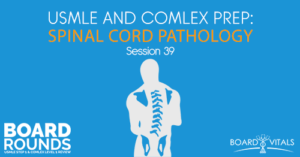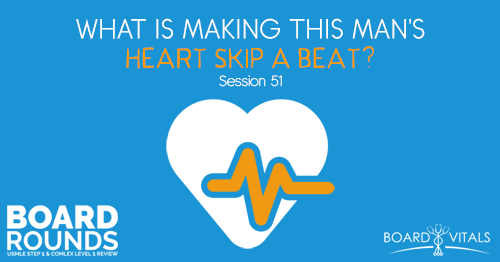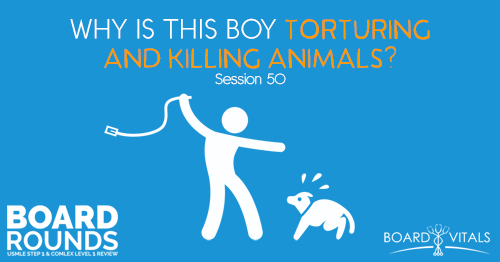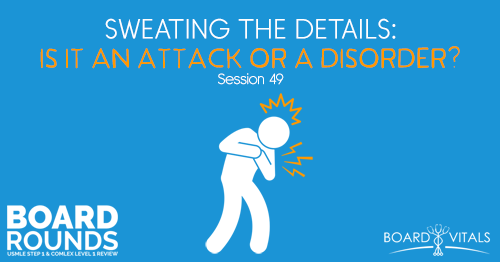[smart_track_player url=”http://traffic.libsyn.com/boardroundsone/br39.mp3″ color=”004075″ title=”USMLE and COMLEX Prep: Spinal Cord Pathology” ]

Session 39
A 70-y/o male has hypoesthesia of the trunk, hypoalgesia, and decreased temperature discrimination. Which diagnosis accounts for residual pallesthesia and fine touch?
Dr. Mike Natter from BoardVitals is joining us once again for some more in-depth look into this. Know more about Mike as he talks about his journey on Episode 373 of The Premed Years Podcast.
If you are looking for some help with your Step 1 or Level 1, go check out BoardVitals and use the promo code BOARDROUNDS and save 15% off any of their packages.
If you’re looking for QBanks, they have you covered with around 1700 and 1900 questions to get you the prep that you need. The best way to prepare for Step 1 or Level 1 is to maximize the number of questions that you do. Obviously not just doing the questions, but reading the explanations.
Also, do check out all our other podcasts on Meded Media for more relevant resources.
Listen to this podcast episode with the player above, or keep reading for the highlights and takeaway points.
[03:09] Question of the Week
A 70-year-old patient has diminished sensation on his trunk, decreased temperature, discrimination and diminished response to pain on the neck, shoulders and trunk.
On the neuro exam on post op day two after repair, dissecting aortic aneurysm, vibratory sensation, and fine touch are preserved. What is the patient’s most likely diagnosis?
Answer choices:
(A) Complete transection of the spinal cord
(B) Posterior cord syndrome
(C) Anterior cord syndrome
(D) Central cord syndrome
(E) Hemisection of the spinal cord
[05:11] Thought Process Behind the Correct Answer
When you think about a full transection, if you did a complete transection of the spinal cord, you would have complete paralysis below that level. And not only that, they mentioned that, and what jumped out is that the vibratory and find touch are preserved.
And the posterior column or the back part is where the vibratory and fine touch are usually at. Right off the bat, we can’t do a complete transection cause you still have some vibratory sense and some fine touch.
Note: Just an idea here, think of it as find-touch-back-scratch. Remembering this clue might just help you.
“Any kind of thing that you can do to recall, like the rote memorization of facts in these cases where they get very granular.”Click To TweetWhat ends up being the correct answer here is actually D, something called central cord syndrome.
And there’s a couple of clues that we can pull out.
First, the central cord syndrome happens to be associated with these aortic aneurysm repairs. And it has to do with this hypoperfusion. Hypo meaning low.
So you’re not getting the blood perfusion to these areas of the cord, specifically the central area because that abdominal aorta is what’s going to have branches off the area.
And as we ruled out the complete transection, we know it can’t be posterior because the vibratory sense is intact.
Then the anterior would give you some other symptoms as well that were not kind of lined up with what we’re talking about.
The hemisection is kind of that Brown-Sequard syndrome where you’d expect half the body to have issues and other half not. So a central cord is the most correct answer that you can go for here.
[07:53] Final Thoughts
This one was very difficult if you don’t remember your neuro track. Hopefully most students can get rid of answer choices A and E right off the bat. And so you’re going from 20% to 33% chance if you had to guess.
So study about your neuro tracks. Where do they go and where is the vibratory sensation? Where is proprioception? Where is heat and where is pain? Like those are all just so important to remember.
Again, make use of clues that you can possibly figure out so you can just piece them together. Or at least rule things out for the most part.
Links:
BoardVitals (promo code BOARDROUNDS and save 15% off)
PMY 373: From Art School to Med School with Dr. Mike Natter
Follow me on Instagram @medicalschoolHQ.
Follow Dr. Mike Natter on Instagram @mike.natter and check out all his amazing artwork.
Listen to Other Episodes
[smart_podcast_player url=”http://medicalschoolhq.libsyn.com/rss” color=”004075″ show_name=”The Premed Years” ]
SEARCH SITE
LISTEN FOR FREE











